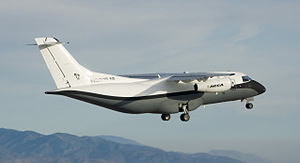Lockheed Martin X-55
| X-55 ACCA | |
|---|---|
 |
|
| Role | Technology demonstrator |
| Manufacturer | Lockheed Martin Skunk Works |
| First flight | 2 June 2009 |
| Status | Development and testing |
| Primary user | United States Air Force |
| Number built | 1 |
| Developed from | Fairchild Dornier 328JET |
The Lockheed Martin X-55 Advanced Composite Cargo Aircraft (ACCA) is an experimental twinjet transport aircraft. It is intended to demonstrate new air cargo-carrier capabilities using advanced composite material. A project of the United States Air Force's Air Force Research Laboratory, it was built by the international aerospace company Lockheed Martin, at its Advanced Development Programs (Skunk Works) facility in Palmdale, California.
The X-55 is a one-off aircraft intended to demonstrate the use of advanced composite materials in the fuselage of an otherwise conventional high-wing transport aircraft. There are no plans to place the X-55 into production.
Lockheed Martin's design for Advanced Composite Cargo Aircraft (ACCA) was chosen over Aurora Flight Sciences' design based on the Antonov An-72 in 2007. The aircraft is powered by 2 Pratt & Whitney PW306B turbofans. The X-55 design is based on the existing Fairchild Dornier 328JET. The fuselage of that aircraft, which is constructed of aluminium alloys, was replaced aft of the entrance door with a newly designed fuselage. The new design makes extensive use of advanced composite materials, selected to allow out-of- curing at lower temperatures and pressures than previous materials. The new widened fuselage allows the loading of cargo through a rear ramp.
The new fuselage section is constructed as a single large component, including the vertical stabilizer. When attached to the existing nose section, the fuselage is 55 feet (16.8 m) long and 9 feet (2.74 m) diameter. The fuselage has upper and lower halves, each with a roughly-oval shape similar to a canoe. The halves are bonded to circular frames. The fuselage section ahead of the entrance door consists of the existing (metal) 328J component, with fasteners used to bring the forward and new aft sections together.
...
Wikipedia
